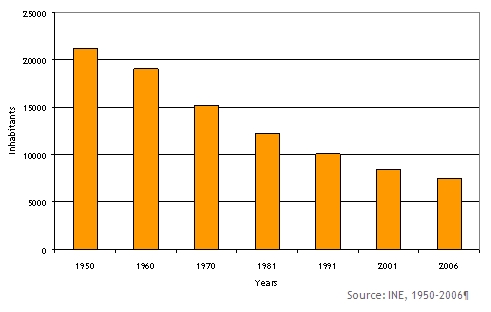Socio-economic description
In 2006, Mação municipality had 7419 inhabitants, with a population density of 18.5 inhabitants/km². Women represented 52% of the total population. For the same year, the birth-rate was 6.3‰ and the death-rate about 23.1‰, which led to a negative growth-rate of 2.2%. Since the 1950s, the municipality has suffered substantial depopulation (Figure 6), with more than 50% of the inhabitants migrating in 50 years.
In terms of age structure, in 2006, the inhabitants under 15 years of age represented 9.7% of the total population while inhabitants more than 64 years old represented 36.8%. In 2008, the ageing index, i.e. the number of persons 60 years old or over per hundred persons under age 15, was about 376. This situation has led to the increasingly aged population, to problems in the generation replacement and to land abandonment (Figure 6).

Figure 6 - Population evolution between 1950-2006 in Mação Municipality (2003)
Although illiteracy has decreased in recent years it remains very high with about 17.5% classified as illiterate in 2001. In 2005, only 16% of the inhabitants were employed, and they were distributed mainly in the secondary and tertiary sectors. The primary sector was very important in the past, but it lost about 72% of the active population between 1960 and 1991. This sector is mainly represented by small-scale farmers working on small holdings. Agro-silvo-pastoral activities have become progressively abandoned, and this has contributed to the low income generated by the agro-forestry sector.
The mean monthly earnings of employees in 2005 were €650.76 (respectively, €708.53 for men and €565.44 for women). Income for the entire municipality is mainly derived from food crops, fodder, firewood, timber and also from old age pensions. Forestry represents one of the major land uses in Mação municipality despite losses due to several large fires in recent decades. For example, between 1990 and 2001, about 60% of the forest area was burnt.
The main impacts of land degradation on local livelihoods are the loss of productivity and soil fertility, water contamination, land abandonment, soil erosion, flooding, loss of biodiversity and also social disruption. Undoubtedly, the major driver of land degradation processes in this area is the occurrence of forest fires. Reasons for an increase in the occurrence of fires are all linked to depopulation and ageing. They include: abandonment of traditional agro-silvo-pastoral practices; monocultural forestry plantations (Eucalyptus globulus and Pinus pinaster); accumulation of inflammable material in the plantations; appearance of new uses in rural areas (mainly related to leisure and recreation), which involve increased access to forest land and therefore increased likelihood of accidental ignitions; droughts; unsustainable management of forest (land tenure and land division through partible inheritance; globalization and market forces; agricultural and environmental policies, not only at the European (EU) level but also at national and local levels; inadequate laws and lack of their implementation and control; low financial resources; and poor access to financial support, among other issues. Reduction of forest fire occurrence and the need for public and private partnerships to the sustainable management of forest represent the major challenges of land resource management in Mação municipality.